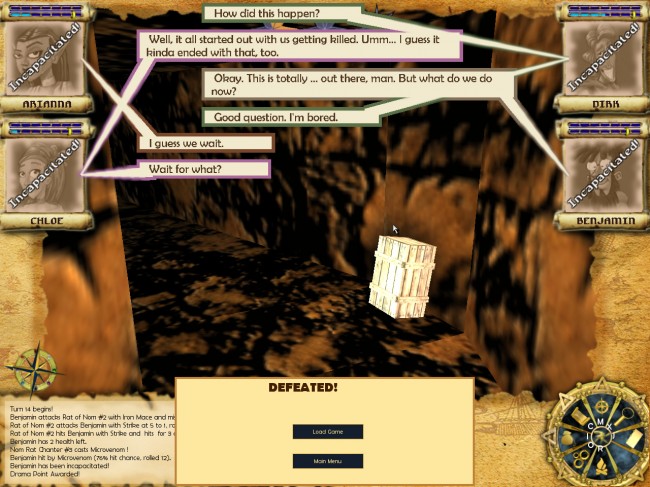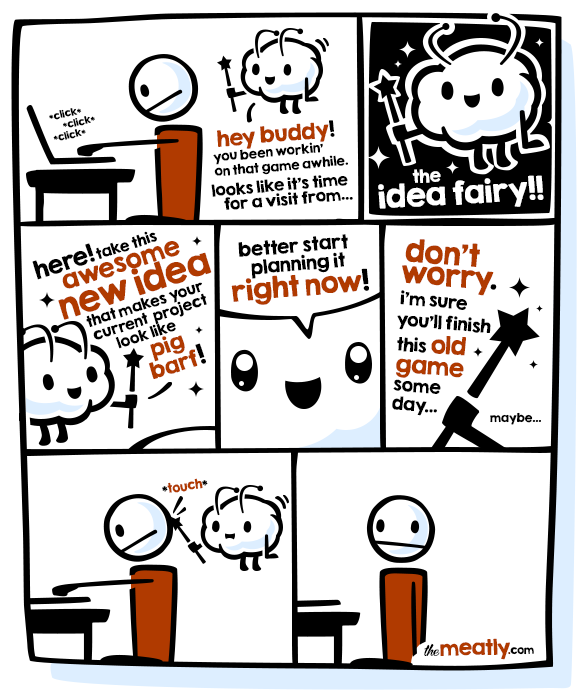Frayed Knights: Humor and the Knights
Posted by Rampant Coyote on July 25, 2014
 Humor is a pretty subjective thing. It’s also something of a cultural thing. I heard recently that part of the decline in film comedies is that so much of Hollywood’s revenue these days is from international markets (more than half), and comedy does not translate well. The kind that does tends to be the overly broad, silly comedy of the type that I personally don’t enjoy.
Humor is a pretty subjective thing. It’s also something of a cultural thing. I heard recently that part of the decline in film comedies is that so much of Hollywood’s revenue these days is from international markets (more than half), and comedy does not translate well. The kind that does tends to be the overly broad, silly comedy of the type that I personally don’t enjoy.
So I make a comedy RPG, thereby limiting my potential market yet again. I am so brilliant.
Oh, yeah, and the game – Frayed Knights: The Skull of S’makh-Daon – is now available on Steam. Have I mentioned that already? 🙂
As I said, overly broad comedy – if it comes on too strong – leaves me cold. I’ve played a couple of humorous RPGs that I really couldn’t take more than a few minutes of. There’s a certain point where things just get too ridiculous for me to care. For me, it still comes down to the characters – if I don’t care about the characters, especially if I cannot care about them because things are just too over-the-top – then nothing else works, and the humor falls flat.
That’s why the characters in the Frayed Knights series are pre-generated. In my mind, if the characters don’t work, the humor and story doesn’t work. Sure, pus golems and “Power Word: Defenestrate” are amusing, but you can’t build a solid, 20+ hour-long game on that. It’ll get old fast.
That’s another issue. Like tragedy, humor is best served by contrast. You can’t just have goofy after goofy forever. You have to ground things in the serious once in a while for whatever is supposed to be funny to really shine. That’s why one of my favorite story points in the game is actually the least funny part of it of all. Those who have played the game and know what’s under the windmill, you know. Now, I know that my skills as a writer are still evolving. (Shameless plug – check out my short story “Dots, Dashes, and Deceit” in Terra Mechanica: A Steampunk Anthology! ) I don’t know if players ever came to care about a certain characters the way I did in my mind. That, and the game plays out for everyone a little bit differently. That’s the interactive medium for you.
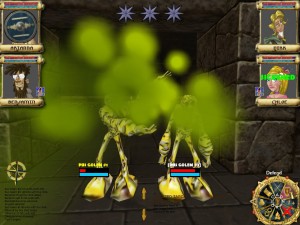 And then I still have my weird setting, D&D-campaign-world-as-envisioned-by-an-inexperienced-but-earnest-14-year-old. It’s full of things like pus golems, pimple gods, obsessive puzzle-building wizards, paper mache dragons, jaded adventurers, spells with names like “hotfoot,” “Boot to the Head,” and “Power Word: Defenestrate”, and sorceresses with names like “S’makh-Daon.” One thing I tried to do (and I think I’m getting better at it as I go) is to make this world – if not believable – at least somewhat consistent. Part of the joke there is for old-school gamers who recognize all the tropes that get abused in computer and console RPGs as well as dice-and-paper gaming – I wanted to explain, lampshade, or subvert all these classic fantasy bits in the context of the world.
And then I still have my weird setting, D&D-campaign-world-as-envisioned-by-an-inexperienced-but-earnest-14-year-old. It’s full of things like pus golems, pimple gods, obsessive puzzle-building wizards, paper mache dragons, jaded adventurers, spells with names like “hotfoot,” “Boot to the Head,” and “Power Word: Defenestrate”, and sorceresses with names like “S’makh-Daon.” One thing I tried to do (and I think I’m getting better at it as I go) is to make this world – if not believable – at least somewhat consistent. Part of the joke there is for old-school gamers who recognize all the tropes that get abused in computer and console RPGs as well as dice-and-paper gaming – I wanted to explain, lampshade, or subvert all these classic fantasy bits in the context of the world.
Sometimes it’s a little over the top. Sometimes its subtle. Sometimes… well, there are spots now where I can now tell I was really trying too hard. It happens.
If I were to do it all over again (which, fortunately, I’m kinda doing right now as I’m working on the next game), I’d do more to ground the characters and the world, and give the player access to their back-story. Again, this would be to make the more humorous parts stand out by contrast. And also because it’s just a fun, bizarre little world that these guys inhabit, and there are forces at work in the world with cool plots and plans in mind that – in my mind at least – amusing, but only if the players feel like they care about the world and what’s going on in it.
So yes, I’m saying I’d try to increase the humor level by … increasing the less humorous aspects. That’s exactly what I’m saying. Not to fear, there will be ridiculous trope-subverting plots and a return of the Rats of Nom and everything else players love about the first game. I’m pretty pleased with how Frayed Knights: The Skull of S’makh-Daon turned out. I’ve heard a lot of great things back from players suggesting that I had more hits than I had misses. But I learned a lot from that game, and hope I can put it to good use in the next one.
Filed Under: Frayed Knights - Comments: 6 Comments to Read
Frayed Knights: The Skull of S’makh-Daon Finally Live on Steam
Posted by Rampant Coyote on July 24, 2014
I was not sure this day will ever happen.
I guess after all this time, nothing short of a miracle will make it anything but anticlimactic. But hey, it’s an Event, and it’s Important, and the stress finally started hitting me a few hours ago.
Frayed Knights: The Skull of S’makh-Daon is finally on Steam.
Yay!
I’m celebrating on this fine state holiday here in Utah by… working extra hours, ‘cuz deadlines. Being a part-time indie can be even more anticlimactic.
But please – share, spread the news! This is a new version of Frayed Knights: The Skull of S’makh-Daon, steam-enhanced with achievements and some smaller fixes / tweaks / improvements. Thanks to everyone who helped make this happen.
I’ll have the non-steam update for people soon. If you bought the game *BEFORE TODAY* from me directly or through Desura and really want the steam version, email me (jayb) with your purchase information, and we’ll work something out. If you got the game through a bundle, check your bundle page. If you don’t have a code already, it should be up in a few hours.
So — now I get to jump to work with the non-Steam updat, and I’m behind schedule on a milestone for the sequel for a week from today. GAH. Okay. Back to work.
Please spread the word.
And thanks. Really. It’s meant a lot to me.
Oh, and one more thing, I just wanted to say… 0L4L6. (UPDATE – This was part of a Steam code contest on Twitter… won now! Grats to @Korovoma on that one!)
Filed Under: Frayed Knights - Comments: 5 Comments to Read
The Origin of Frayed Knights: Classic CRPGs Edition
Posted by Rampant Coyote on July 23, 2014
Frayed Knights: The Skull of S’makh-Daon releases TOMORROW on Steam. Assuming all goes well and there’s no surprises. At least no major ones. There are always surprises. Wish me luck. And tell your friends!
I did a series a long time ago called “How CRPGs Warped My Brain.” I could just about revisit that entire series and demonstrate how they influenced Frayed Knights‘ design. But I figured I’d just go into some specifics… maybe five of the most influential games, the ones with a particular vibe I was trying to channel.
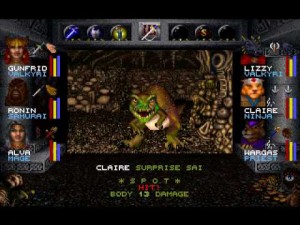 I’d say the biggest influence on the design is a game I never finished – or even got THAT far in playing: Wizardry 7: Crusaders of the Dark Savant. This is a game that is permanently in my “I want to finish some day” list. It’s awesome. It’s deep. It’s huge. It took some risks. It was beautiful – even today. And of course, it was a first-person perspective game with a party of characters, with the additional old-school vibe of having a pedigree going back to one of the earliest commercial computer RPGs.
I’d say the biggest influence on the design is a game I never finished – or even got THAT far in playing: Wizardry 7: Crusaders of the Dark Savant. This is a game that is permanently in my “I want to finish some day” list. It’s awesome. It’s deep. It’s huge. It took some risks. It was beautiful – even today. And of course, it was a first-person perspective game with a party of characters, with the additional old-school vibe of having a pedigree going back to one of the earliest commercial computer RPGs.
A lot of the very interesting things it did – like having a faction system with competing parties, diplomacy, and a text parser for conversations – I didn’t really run with in Frayed Knights. But it was a part of why I was in awe of the game when it was released. But it all contributed to making the world feel much more alive, which is something that is important in any CRPG. But perhaps more important was the variety of actions, puzzles, and approaches to problems you could take to move forward in the game, down to which factions you ally with. And of course, there was the classic Wizardry “phase-based” combat system which required some prediction and risk assessment. It wasn’t great, but it was good and challenging.
For me, Wizardry 7 was kind of the standard. Possibly because I hadn’t played much of the Might & Magic series at the time I started work on Frayed Knights… but that’s another story.
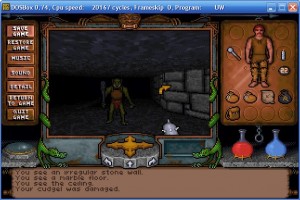 Next – there’s Ultima Underworld. Both games, but particularly the original. This was the first of the “true 3D” first-person RPGs, the predecessor for the Elder Scrolls series. I even went so far, at one point, in creating a control scheme similar to Ultima Underworld‘s for Frayed Knights during the early prototype stage. Then I recognized how terrible it was, and instantly repented.
Next – there’s Ultima Underworld. Both games, but particularly the original. This was the first of the “true 3D” first-person RPGs, the predecessor for the Elder Scrolls series. I even went so far, at one point, in creating a control scheme similar to Ultima Underworld‘s for Frayed Knights during the early prototype stage. Then I recognized how terrible it was, and instantly repented.
While Underworld’s gameplay is nothing like Frayed Knights‘, I really liked the more intimate, detailed dungeons, and – like Wizardry 7, it had a world that really came alive a number of ways. It was detailed. The world, the levels, the NPCs all had a solid backstory. There was a plethora of things to do besides just kill monsters. There was again something of a simulationist, open-ended design to some tasks. For example, you could either find the key to a door, or beat the door down. You could negotiate, or take.
But one of the things I most liked about the game was that it felt… fresh and maybe a little bit raw. The designers created it without the type of limitations that frequently infected the other RPGs of the era. It felt a little more like the kind of game they’d make for their table-top gaming group, full of weird ideas that more experienced designers would have nixed in the planning stages because they were too complicated to implement. Not that Paul Neurath was a total newb at this point, but it does feel like they were a little more wild and free with their design. I totally wanted that in Frayed Knights.
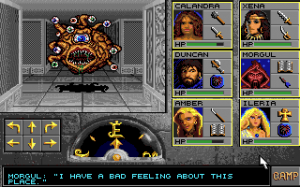 In the old classics arena, the Eye of the Beholder series – particularly #2 (the only one I played to completion), was also an influence. Sure, it was derived heavily from Dungeon Master (which I also played, on a friend’s Amiga). I liked how they took the real-time, exploratory, interactive world of Dungeon Master, mixed it with the D&D rules, and gave it some story. And yes, like the other two games, part of my delight was in the interactivity of the world, the variety (to a point) of environmental puzzles and the look of the world.
In the old classics arena, the Eye of the Beholder series – particularly #2 (the only one I played to completion), was also an influence. Sure, it was derived heavily from Dungeon Master (which I also played, on a friend’s Amiga). I liked how they took the real-time, exploratory, interactive world of Dungeon Master, mixed it with the D&D rules, and gave it some story. And yes, like the other two games, part of my delight was in the interactivity of the world, the variety (to a point) of environmental puzzles and the look of the world.
(And as a side note – when are we going to get that series on GOG.COM? Just askin’….)
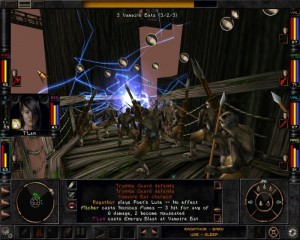 I’d never played Wizardry 8 until I was knee-deep in development of Frayed Knights: The Skull of S’makh-Daon. I fell in love with it almost immediately. I grew to hate the length of combats, however (I timed them at one point, in the late-game stages, and found myself spending almost an hour in a single fight, even using a hack to speed up the combat animations and spell effects). But it represented almost everything I loved about Wizardry 7. Plus, a true 3D environment. It was too late for it to have a serious influence over my design, but since both drew upon its predecessors for inspiration, I guess it’s unsurprising that there’d be some similarities.
I’d never played Wizardry 8 until I was knee-deep in development of Frayed Knights: The Skull of S’makh-Daon. I fell in love with it almost immediately. I grew to hate the length of combats, however (I timed them at one point, in the late-game stages, and found myself spending almost an hour in a single fight, even using a hack to speed up the combat animations and spell effects). But it represented almost everything I loved about Wizardry 7. Plus, a true 3D environment. It was too late for it to have a serious influence over my design, but since both drew upon its predecessors for inspiration, I guess it’s unsurprising that there’d be some similarities.
But as so much time had passed since I had played much of Wizardry 7, playing its immediate (if a decade removed) sequel was a great refresher course in what I loved about the series.
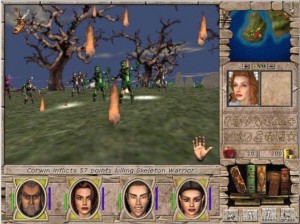 Likewise, Might & Magic VII – in fact, the whole Might & Magic series – was a late discovery that I only came to appreciate after Frayed Knights was in development. I’d played a little bit of Might & Magic III way back in the day, but hadn’t gotten into it as much as some of its contemporaries. And I’d read so much about the Xeen games that I knew what to expect, more or less. But really getting into the games for the first time, many years after their creation? What a fun experience. And I couldn’t help but draw upon these as an influence in Frayed Knights. In particular, the ability to increase your characteristics with objects you find in the game world was something I borrowed -mainly because it was a really fun, rewarding mechanic.
Likewise, Might & Magic VII – in fact, the whole Might & Magic series – was a late discovery that I only came to appreciate after Frayed Knights was in development. I’d played a little bit of Might & Magic III way back in the day, but hadn’t gotten into it as much as some of its contemporaries. And I’d read so much about the Xeen games that I knew what to expect, more or less. But really getting into the games for the first time, many years after their creation? What a fun experience. And I couldn’t help but draw upon these as an influence in Frayed Knights. In particular, the ability to increase your characteristics with objects you find in the game world was something I borrowed -mainly because it was a really fun, rewarding mechanic.
I’d be hard-pressed to find a favorite CRPG that didn’t wasn’t something of an inspiration or influence (if only as an example of what not to do). These are the five games I drew from the most as I was trying to distill all the things I remembered from classic CRPGs that made them so fun.
Perhaps the biggest influence is that, in spite of years of experience, I still thought that somehow with modern technology I could make a stupidly huge RPG with all kinds of cool features with a tiny team and a shoestring budget. While I will be the first to admit that I landed somewhat short of the mark I’d envisioned in my mind’s eye when I started, I’m pretty dang proud of what was accomplished. We learned a lot, we grew a lot, we created something unique and original that still hearkened back to the classics of an earlier era, and which is – most importantly – fun.
Filed Under: Frayed Knights - Comments: 7 Comments to Read
Frayed Knights – Steam Store Page Up, Community Support Needed
Posted by Rampant Coyote on July 22, 2014
Okay, folks. I can use some help here.
I know many of you have already played through all or most of Frayed Knights: The Skull of S’makh-Daon. If you have, I could use some support :
Frayed Knights: The Skull of S’makh-Daon on Steam
I could use some reviews, community discussion, support, screen shots, etc. there.
If you previously obtained the game from Rampant Games directly and are willing / interested in writing a review on Steam this week, please let me know via email or twitter PM. The jayb addy works best. I’m trying to get a lot of things done quickly, and I may even push out the release date a few days if I have to, but I can use every bit of support you guys are willing to offer. I’d love the site to have content from people other than me on launch day (or shortly before / after, where possible).
Thank you all for your help – big and small. Even little words of encouragement and optimism (when I felt little, myself) helped a great deal.
Filed Under: Frayed Knights, Rampant Games - Comments: 15 Comments to Read
Frayed Knights: Changes to version 1.07
Posted by Rampant Coyote on July 21, 2014
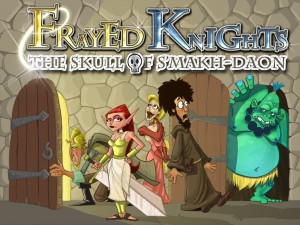 Over the course of the week, I made some changes to Frayed Knights: The Skull of S’makh-Daon that go beyond adding Steam achievements. This will be version 1.07, and will be made available for non-Steam versions soon.
Over the course of the week, I made some changes to Frayed Knights: The Skull of S’makh-Daon that go beyond adding Steam achievements. This will be version 1.07, and will be made available for non-Steam versions soon.
The changes are small, but (IMO) significant:
* Change to the Search skill. When there is a hidden treasure within range of the skill, you will get a message to that effect even on a failed check – just no indication of range. There is no change to searching for traps.
* Weapons with spell effects on impact (for example, the Spear of Concussion and the Axe of Fiery Microdoom) now may cost additional stamina when the spell effect lands. These are generally pretty low-level spells so the endurance cost isn’t major, but it does help balance out the otherwise quite impressive effects of these weapons.
* The Endurance cost modifier for the Demotivate spell has been increased from 3 to 4.
* Fixed a bug when attempting to cast directly from a scroll onto a friendly party member – the casting dialog would sometimes have scrambled information.
* Some minor dialog changes, mainly for typos.
I suspect that the change to search will be the most well-received, with the average response being something to the effect of, “It’s about time!”
Filed Under: Frayed Knights - Comments: 3 Comments to Read
Ultima IV and Rational Worlds
Posted by Rampant Coyote on July 18, 2014
 I’m gonna take a break for the weekend on the Frayed Knights posts (more next week!), and just refer you to a couple of posts by The Digital Antiquarian about a game that’s very near & dear to my heart, Ultima IV.
I’m gonna take a break for the weekend on the Frayed Knights posts (more next week!), and just refer you to a couple of posts by The Digital Antiquarian about a game that’s very near & dear to my heart, Ultima IV.
First, the origin story – and some conjectures about the real history behind it that go beyond the short & sweet “official” story:
Now, as much as I like to wax prosaic about Ultima IV, because it really was a pretty landmark game and IMO still a great game to play, it is still a (relatively) simple game with simple mechanics. Although the interesting thing is that while modern games with complex faction systems may be far more sophisticated, the simple rules and ability to check with Hawkwind to monitor your progress may have actually strengthened the focus of the game and increased the verisimilitude than far more murky but “realistic” systems. Go figure.
But maybe a more significant factor – and reason that the game series is so beloved today – is suggested in the second article. Though violated as often as reinforced, a logic and consistency permeated the Ultima games. This was a part of game design as well as the fictional world-building. At least through the middle of the series, the games were far more simulationist than narrativist. The game ran on consistent rules with very little special-case code. The player acquired and learned to use tools to make progress in the game – from finding an artifact to fly over mountains to using a cannon to shoot a door off its hinges.
The magic system tried to follow that same consistency – it seemed to be created of a combination of elements, which included reagents some games, and runes in Ultima Underworld. Likewise, the virtue system was a combination of a handful of base elements. In Ultima VI and VII, crafting and simple economy were introduced much the same way, with a number of basic procedures allowing the creation of items in the game.
Maybe it was the transparency of these systems – and how they permeated the same game – that made players feel like Origin was living up to its motto, “We create worlds.” And maybe there’s a lesson to be learned by game designers (especially RPG designers) about the art of world-building.
Filed Under: Retro - Comments: 5 Comments to Read
The Origin of Frayed Knights: Dice and Paper Edition
Posted by Rampant Coyote on July 17, 2014
Long-time readers may be plenty familiar with some of this already. But with the first Frayed Knights game coming out on Steam (hopefully a week from today) and the sequel making progress towards its first fully playable demo, I figured I’d go back over a little bit of the history of the series.
The Frayed Knights series was inspired by a number of sources. I’ll talk about the computer RPG origins in another post, but the Bard’s Tale, Wizardry, and Ultima series (and some lesser-known games) were of course old-school classics that informed my design and I wanted to emulate some of the feel of playing those games.
But a lot of it was inspired by the source of inspiration for all of those games – dice-and-paper gaming, particularly the first edition Advanced Dungeons and Dragons era. The characters making snarky comments as if they were players sitting around the table was a direct effort on my part to capture some of that feeling, mixed with a bit of tongue-in-cheek humor, of course.
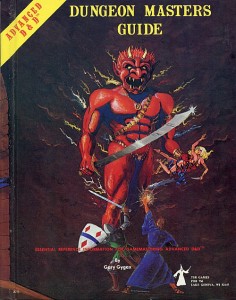 Dice-and-paper gaming is different now. Honestly, I play Pathfinder now rather than 1st edition AD&D because I prefer the new system, and I really caught the vision of the “World of Darkness” series with its emphasis on storytelling. So don’t get me wrong – I’m not going to tell you that 1E was the be-all, end-all of gaming. But it was a different experience back then – one that was partly lost a few years later, and is only now being somewhat re-discovered by computer RPGs. The recent opinion piece at Polygon, “The dice can kill you: Why First Edition AD&D is king,” manages to describe some of that “feel.”
Dice-and-paper gaming is different now. Honestly, I play Pathfinder now rather than 1st edition AD&D because I prefer the new system, and I really caught the vision of the “World of Darkness” series with its emphasis on storytelling. So don’t get me wrong – I’m not going to tell you that 1E was the be-all, end-all of gaming. But it was a different experience back then – one that was partly lost a few years later, and is only now being somewhat re-discovered by computer RPGs. The recent opinion piece at Polygon, “The dice can kill you: Why First Edition AD&D is king,” manages to describe some of that “feel.”
That’s part of the feel I was going for.
In fact, that’s kind of the strength AND the weakness of the system. In the old 1979-era Advanced Dungeons & Dragons game, the setting and mood built into the rules. From the race and class restrictions, racial attitude modifiers, to even things like the insanity tables. You could ignore all that, sure… but if you even moderately adhered to the rules, the setting and flavor of those old D&D games would be spontaneously generated by dice roles. Kinda like a roguelike.
But perhaps more importantly, there was a geeky subculture around those early years which spread by contact with other gaming groups, conventions, and in the pages of the manuals and Dragon Magazine. It was wild stuff back then, to play a game so insanely free-form that there wasn’t even a conventional notion of a winner. Creativity ran rampant, from the mundane to the bizarre.
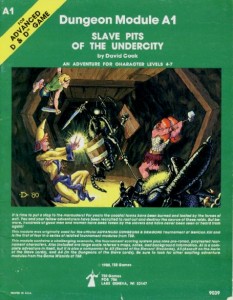 Modules and supplements back then had the really awesome pulp-fantasy names like “Queen of the Demonweb Pits,” “Assault on the Aerie of the Slavelords,” “The Caverns of Thracia,” “Tomb of Horrors,” “The Ghost Tower of Inverness,” “City State of the Invincible Overlord,” “Against the Cult of the Reptile God,” “Expedition to the Barrier Peaks,” etc. Man, I loved those titles. And the modules – while not always expertly delivering on the promise of those magnificent titles – were great foundations on which a gaming group could build an experience.
Modules and supplements back then had the really awesome pulp-fantasy names like “Queen of the Demonweb Pits,” “Assault on the Aerie of the Slavelords,” “The Caverns of Thracia,” “Tomb of Horrors,” “The Ghost Tower of Inverness,” “City State of the Invincible Overlord,” “Against the Cult of the Reptile God,” “Expedition to the Barrier Peaks,” etc. Man, I loved those titles. And the modules – while not always expertly delivering on the promise of those magnificent titles – were great foundations on which a gaming group could build an experience.
That was really the key. While everyone who had played The Keep on the Borderlands had somewhat similar experiences based on the module, it was a little (or a lot) different for everyone. When I envision an “ultimate computer RPG” – which I hope to play (or even build) one day, that’ll be a major part of it. A luxuriously hand-crafted world and plot, and the player has a ton of freedom to do things how he wants, and have the game react appropriately. It was a (distant) goal in Frayed Knights, which resulted in lots of duplicate dialogs with slightly different variations.
The banter at the table was of course a major part of trying to recapture that experience as well. My mental model for the world was a campaign setting invented by a gifted, earnest, but not entirely clueful 14-year-old with delusions of grandeur (sound familiar?), totally missing the lack of logical consistency inherent in both the world and the rules. Hey, that means I did all that deliberately, doesn’t it? The party members are characters played by somewhat more experienced players who are playing along and just having fun role-playing their characters, papering over the inconsistencies in the world with brilliant explanations for why things work the way they do.
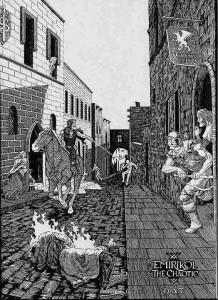 Some of the aspects of old-school D&D and similar games I just imitated (I won’t say I parodied or paid homage to, but maybe there was a little of both) was the ungodly number of spells (and items) in the core game. It’s both brilliant and terrible. For me, trying to balance all these items and spells was a little bit on the terrible side. But the point of AD&D was to make sure there was so many cool things for players to use (or have used against them) that the game would stay interesting through dozens of campaigns. It worked!
Some of the aspects of old-school D&D and similar games I just imitated (I won’t say I parodied or paid homage to, but maybe there was a little of both) was the ungodly number of spells (and items) in the core game. It’s both brilliant and terrible. For me, trying to balance all these items and spells was a little bit on the terrible side. But the point of AD&D was to make sure there was so many cool things for players to use (or have used against them) that the game would stay interesting through dozens of campaigns. It worked!
For the most part, I only tried to reference / parody the feel of those old game sessions of that era. There were a few specifics that I remember making fun of. The Caverns of Anarchy are, of course, a reference to the Caves of Chaos in The Keep on the Borderlands. Honestly, I don’t think of it as a great module – I think Gygax was kinda phoning it in on that one to throw in an obligatory introductory adventure for their new, streamlined, simpler version of D&D. (As an aside, I think the 1981 Basic / Expert D&D set was one of their best-designed products, ever). But it was the first D&D experience for many players of the era, and it was a pretty early one for me, too. The “mad hermit” kinda makes an appearance, although he explains that he’s not mad, just mildly pissed-off and cantankerous. I deliberately avoided much more by way of specific references to that module, but instead took the idea in a few directions, keeping only the concept of a bunch of monster lairs in close proximity (a “monster apartment complex” as I once heard it described).
The level of randomness of the dice & paper games is something else I emulated, although I actually backed off a good deal from my original efforts. When three or four battles in 1st edition Advanced D&D would take up a great deal of a four-hour gaming session, the randomness of the occasional die-roll feels more acceptable. But in a computer game, when combats are resolved in a couple of minutes, there are LOTS of rolls, lots of chances to die, and players (including me) get frustrated with too much inconsistency.
Some of the other stuff – well, I’ll just say I spent a lot of time going over old Dragon Magazine articles and classic modules, rulebooks, and supplements for both ideas and a proper “old-school dice & paper feel” for the game. Whether I succeeded or not is in the eye of the beholder, I suppose. But I have certainly enjoyed the experience.
Filed Under: Frayed Knights - Comments: 2 Comments to Read
Frayed Knights: A Slightly New and Improved Trailer
Posted by Rampant Coyote on July 16, 2014
I came to the stark realization the other day that the original trailer for Frayed Knights: The Skull of S’makh-Daon still had the words “Coming Soon” at the end. I figured I’d jump in and just change that particular title and make a quick revision. This was mainly for Steam, but I figured I’d put that everywhere.
I guess that shows how much I know. I don’t upload much to YouTube, so while I was vaguely suspicious that you couldn’t replace an old video with a new one, I wasn’t sure about that. But that’s another story.
But one problem was that I’d had a hard drive crash and an upgrade of Windows from Windows XP to Windows 7 in the interim. Yes, I skipped Vista, and I am skipping Windows 8, just like I skipped Windows ME. So far, that strategy has worked fabulously for me.
Anyway – while much of the raw data was still there, I had to install new versions of the software which were incompatible. An older version, which I eventually had to reinstall, is buggy and prone to crashing / hanging. *Sigh*. I haven’t touched the software in a while, so I had to re-learn how to use it, and it took me a while – and several reboots of the software and re-doing previous work – to get into the habit of saving after every change. Because, of course, I couldn’t let well enough alone, and I decided to make some other tweaks. Changing the font, tweaking a couple of of the clips, changing the wording of a couple of titles that had bugged me for a while…
… And then I realized that I’d actually started with the wrong version of the project file. It was close, but it wasn’t exactly what I’d used to make the original trailer. Ah, well. I didn’t feel like going back and changing things AGAIN, so I just rolled with it. At this point, anything that seemed different felt like an improvement.
The first version I made – even published to YouTube – had a typo, so I revised it yet again. Unless I find something else embarrassingly wrong with it, this will be the trailer that will run for the Steam release (and it’ll probably replace the one I have on the Frayed Knights page, and on the Desura store page as well).
And yes, when we talk about how much stuff goes into being an indie that doesn’t involve making the game, this is one of the many, many, many things we’re talking about. You either take time you don’t have to do it yourself, or you pay with money you don’t have to have someone else do it.
Anyway, if it looks good, feel free to give it a thumbs-up or comment or something.
Filed Under: Frayed Knights - Comments: 5 Comments to Read
Frayed Knights: Am I just a cruel game designer?
Posted by Rampant Coyote on July 15, 2014
Am I just a cruel game designer? Are there any other games out there that have one of the longest dialogues in the game take place after the entire party has been wiped out? Is this me trying to be funny and take the edge off a frustrating situation, or was it me just rubbing it in?
I like to think the former, but sometimes I’m not sure.
Now, technically, I was trying to get a TPK (Total Party Kill) here, but the rats in Farmer Brown’s cellar are particularly nasty and make it pretty easy. But not as nasty as the critters at the Tower of Almost Certain Death. One of the challenges of going more “open” in design is that the player won’t necessarily take the smoothest path. If the player bypasses some of the little missions in town (including Farmer Brown’s cellar) and the mines in the Eastern Wilderness to go straight for the Tower of Almost Certain Death, and pushes straight for the top of the tower, it’s going to hard to avoid either getting a lot of TPKs and / or a lot of visits back at the inn.
I guess, in retrospect, I should have had Benjamin’s “tip” take the player to an easier dungeon, like the mines. Now, in my mind, there’s a gameplay / philosophical rationale here. But it may just be that subconsciously I’m just a really cruel game designer.
Anyway – if you are a new player to the game and are looking for hints, this is one: Unlike many RPGs, you aren’t expected to make a beeline between your quest areas. In fact, there may be forces at work (NOT ME!) that are intentionally trying to push your party to failure. Take some time to smell the roses, go off the beaten path, and explore some of that terrain. You may find buried treasure. You may find a fierce enemy. You may find a whole dungeon that no “quest” pushes you to visit. And yes, you could find yourself completely in over your head in a few places, which may lead to that that dialog in the screenshot becoming completely un-funny. You may find your entry barred by something you cannot solve just yet. But it’s all okay.
I tried my best to make sure you can’t break the game this way. Much of the better loot can be found in “optional” dungeons. And the dungeons and countrysides are literally littered with little events, secrets, and dumb jokes.
Frayed Knights: The Skull of S’makh-Daon is coming soon to Steam, but it currently available at our website, if you do not want to wait.
Filed Under: Frayed Knights - Comments: 3 Comments to Read
Frayed Knights Update: Achievements
Posted by Rampant Coyote on July 14, 2014
 Frayed Knights: The Skull of S’makh-Daon will be up on Steam in a matter of days. It could have been done a lot sooner, but in my stupidity / eagerness, I decided to add achievements to the game.
Frayed Knights: The Skull of S’makh-Daon will be up on Steam in a matter of days. It could have been done a lot sooner, but in my stupidity / eagerness, I decided to add achievements to the game.
I don’t know if it’ll make a bit of difference in sales. But I thought it would be fun. I’m stupid that way, I guess. I have a hard deadline of a demo for Frayed Knights 2 that demands my attention, so the timing is bad. I’m futzing about with the old game, getting someone to do the icons, programming the changes in code that I haven’t looked at in over a year, and then… testing. Lots and lots of testing. Even with debug controls, we’re talking double-digit testing to make sure the game runs correctly with the code changes.
Ah, well. Why do I do this? Because it’s fun. I don’t know if achievements will help sell a single extra copy of the game, but I do this because it’ll make things a little cooler. Hopefully. I can’t depend on awesome high-end graphics and visuals, so I’ve gotta do something, right?
It’s a little weird digging through the old code. After living with this stuff for so long, it’s like going back to the old neighborhood but not quite remembering everything. I don’t have all the tools installed that I used when I worked on it originally, so it’s a little bit harder to find where everything is, although it’s familiar enough that I haven’t had to dig around too much.
I decided against creating achievements that required psychotic multiple play-throughs… I already inflicted that on playtesters back in the day. You will definitely need to explore optional content and uncover a few secrets to get all the achievements, and some of the achievements may require you to make certain choices you might not have made on your original play-through (although if you have a prior saved game, it’s not hard to go back and try alternatives). I guess I just don’t feel it should require ridiculous levels of tedium and effort to get 100%.
Filed Under: Frayed Knights - Comments: 11 Comments to Read
Game Dev Quote of the Week: Bits of Awesomeness Edition
Posted by Rampant Coyote on July 11, 2014
This Game Dev Quote of the week comes from a team effort by the wild, weird, awesome guys at Dejobaan Games, circa 2010, in a post-mortem about one of my favorite indie games, AaaaAAaaaaaah! A Reckless Disregard for Gravity.
An excellent video game isn’t just about presenting interesting rules — it’s about delighting the player with bits of awesomeness all over the place. The best arcades did this well during the ’80s.
In their heyday they were like miniature Las Vegases for kids, filled with interesting details. At the core were the games — but they weren’t just all dumped into a dusty warehouse. Step inside one now — the decor (tacky, yet awesome) starts with a pitch black room with wavy neon lights and disco balls. The cabinets are densely-packed, with illustrations sprawling over them. Peek around to the front of each one, and you get a glimpse of a ridiculous matrix of lights playing out. Off in one corner of the room is an illuminated glass cube filled with plush toys and a gleaming claw.
While you’re picturing the ambient glow, listen to the sounds of a dozen games beckoning with their distinctive sounds. The best arcades were spaces to explore. And like that, our favorite games delight us all over the place — it’s a little like stumbling across little Christmas presents wherever we go.
We tried to do this with Aaaaa!, starting with a solid core of gameplay. If we could then make people grin at something as silly as the options menu — and then apply that to all the details — people would want to keep playing the game just to see what’d happen.
So! BASE jumpers must lose a lot of teeth — why not make teeth the game’s currency? Elevator music in the level selection menu? Sure! And we included a guided anti-meditation, in case you lived a life of too much relaxation, and wanted to feel as though bugs were crawling around your body. Each little piece made the game stand out a little more.
Another example of excellence in this respect is the game Rock of Ages – which I think might be kind of a boring game if it weren’t for all the delightful details.
You can read more in the Aaaaaaa! Post-mortem. Full of little bits of awesome!
Filed Under: General - Comments: Read the First Comment
Grim Fan-Frickin’-Dango!
Posted by Rampant Coyote on July 10, 2014
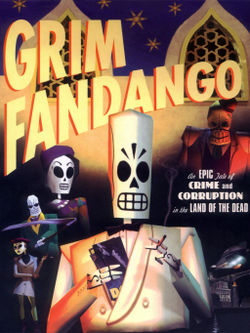 Confirmed: The “remastered” edition of Grim Fandango announced for the Sony PS4 and Vita platforms is also coming to PC, Mac, and Linux.
Confirmed: The “remastered” edition of Grim Fandango announced for the Sony PS4 and Vita platforms is also coming to PC, Mac, and Linux.
I still have my original copy. And the box. Getting it to actually *run* in a modern Windows environment without crashing is a major feat requiring hunting the internet and possibly running dubious files. But I do have it. It is a well-loved copy.
Just by way of reference – I received it as a Christmas present, alongside the original Half-Life.
Have I mentioned lately that I consider Grim Fandango to be the best adventure game of all time? Well, I do. My apologies to all my adventure-game developer friends and acquaintances out there. I love what you are doing guys. Maybe you’ve got a game out there that I haven’t played that equals or exceeds the majesty of Grim Fandango, and one day I will discover it and revise my proclamation. But of the adventure games I have played, Grim Fandango remains my high-water mark.
And honestly, I cannot tell you why. It wasn’t the puzzles. I only barely remember some of the puzzles. (“Run, you pigeons! It’s Robert Frost!”). Mainly, it was the characters – particularly the protagonist, Manuel “Manny” Calavera. And Glottis. Glottis was great. And the oddball setting. And the film noir style. And the awesome story broken up into chapters each set a year apart. And the excellent soundtrack.
Mainly, I remember how I felt playing it. This was 1998, and getting a more subtle emotional reaction (meaning – something besides fear or anger) from a game was a rare thing. But I did with Grim Fandango. I cared about the characters, and the ending left me feeling satisfied. It was a well-told story and a well-crafted game.
Technologically, I’m not sure how well the “remastered” edition will stack up to modern offerings. But it’s definitely a classic that deserves to be made available on modern platforms. I’m really excited by this news.
Filed Under: Adventure Games, Retro - Comments: Read the First Comment
Beware the Idea Fairy
Posted by Rampant Coyote on July 9, 2014
I just discovered theMeatly.com last night. Maybe it was the caffeine talking, but I was literally laughing out loud at many of the panels. Especially this one.
If you are an indie game developer, this is probably the story of your life. Every. Day.
I’ve taken to just writing the dang things down – writing up a page or two of stuff about the idea, and filing it away in my game design folder, and telling the idea fairy, “THANK YOU! It’s started!” Then when its back is turned, I go back to my original project.
Although sometimes, it takes a little more than that. That’s when a weekend personal game jam or something comes into play. I never get anywhere close to what I originally envisioned. My little totally awesome killer idea that makes my current project look like pig barf ends up looking something like this…
Oh, man, that one also brings tears to my eyes from laughing so hard.
The thing is… the idea fairy is never satisfied for long. Writing down the idea or doing a quick prototype might satisfy the urge and convince the idea fairy to go away for a few days. Well, for a day. Maybe a few hours. At least an hour. Usually. Indulging it even a little bit really just encourages it. It comes back … again, and again.
Now, this isn’t really a bad thing. You want to be on friendly terms with the idea fairy. One day, when I’m all done with Frayed Knights and ready to work on the next project, I will have this awesome list of killer game ideas from which I can choose the absolute best concept. In fact, that’s how Frayed Knights came about.
But resisting the temptation to start playing with this shiny new idea right away can be very hard. You may have to pull a Ulysses and figuratively lash yourself to the mast so you don’t succumb to the siren’s call.
If the idea fairy is persistent after you’ve performed your ritual acknowledgement, one trick is not to do what I do. Don’t write games that take a long time to develop. The longer they take, the more persistent the frickin’ idea fairy becomes. It’s easier to resist the idea fairy when the current project is new and exciting, and when your project is getting close to release. Therefore, it’s good to reduce the window between those phases as much as possible.
Another is to do all you can to commit to a project such that it will be a major embarrassment or otherwise a pain to stop or delay it. Making yourself accountable to a third party with deadlines can help with that. By making it far less painful to stay the course and see the current project to completion, the easier it is to resist those temptations.
Just remember – ideas are great and important, but in the end, it’s the execution that matters.
(And pssst…. go visit theMeatly.com!)
Filed Under: Game Development - Comments: 4 Comments to Read
Playing Bad Games…
Posted by Rampant Coyote on July 8, 2014
Across the street… a neon sign.
“All you can eat for a dollar ninety-nine.
Our soul stew is the baddest in the land.”
But uh, one dollar’s worth was all that I could stand.
— Huey Lewis and the News, “Sometimes Bad is Bad.”
It’s often easier to figure out what has been done wrong than what has been done right.
For that reason, there’s virtue in playing bad games if you are a game developer. I may not know what to do to make a better game, but I can get a good list of “what not to do.” Bad games can be a stinky treasure trove of game design lessons.
Plus, there are some games that are really not great games, but do have some really great ideas or mechanics buried in the crap. In these cases, the baby frequently gets thrown out with the bathwater, and those ideas may never be revisited again. Mediocre or bad games can be mined for good ideas.
And sometimes, a game has enough virtues to be worth turning it onto easy mode and just plowing through the crap to enjoy the good parts. They aren’t irredeemable.
But sometimes, bad is bad, and a game’s greatest virtue is to serve as a cautionary tale.
(And no, I’m not going to admit what game I played a little of this weekend that served as the inspiration for this post. I’ll only say it’s not an RPG, and it’s not irredeemably bad, but I could write several paragraphs on what it’s doing wrong.)
Filed Under: Design - Comments: Read the First Comment
Pixels 4Ever?
Posted by Rampant Coyote on July 7, 2014
Old-school bitmap art can be pretty dang awesome. Like this, from the incredibly cool arcade-style freeware game Maldita Castilla, by Locomalito Games. Check it out – it’s freeware. Tip the creator with the number of quarters you would have dumped into this game if it had been in an arcade machine:
My kids and I thoroughly loved Towerfall for the Ouya. The new version has the hottest modern gaming hardware pushing 2D pixels like it’s 1992. While IMO the graphics weren’t quite as amazing as Maldita Castilla, they didn’t need to be. They were as good as they needed to be to support the outstanding gameplay. If you think this looks like fun, you’d be right:
Supporting the gameplay is really the key.
One of the problems with more realistic and detailed graphics – every possibility has to be meticulously modeled / animated / rendered. The answer to this, as budgets skyrocket, is to limit the breadth of interactions so that you don’t end up with the combinatorial explosion of necessary assets and variations. For example, you might have a game concept with a cool idea like, “Oh, what if we set a guy on fire, and THEN blow him up with an explosive arrow, and then his exploding, flaming chunks sets everything they touch on fire?”
My inner 14-year-old thinks this is the coolest idea ever. In a game like Towerfall, you’re talking maybe a half-day of coding, and maybe a day or two of art assets and variations. But if you were working on the latest Call of Duty game (one of my favorite punching bags for AAA gameplay, not that they are bad games… I do enjoy them, but they are what they are), you could be talking many hundreds of man-hours going into implementing the same feature. In a simpler game, it could be implemented on a whim. But in a AAA game, it will probably never make it past the brainstorm phase.
The Verge published an article a few days ago about the 8-bit / 16-bit “retro” style of game graphics that are very popular these days with indie games. Entitled “Pixel art games aren’t retro, they’re the future,” it opines that while the graphics that would have been at home on a console twenty years ago might be there in part out of retro sensitivities and (somewhat) easier / cheaper development for indies, those are not the only reason it’s popular. Done well, the art won’t age as attempting to push the “realism” levels will. It invites the player to judge a game by a different criteria than the AAA blockbusters with tens of millions of dollars of budget, and maybe more importantly – it’s an artistic style.
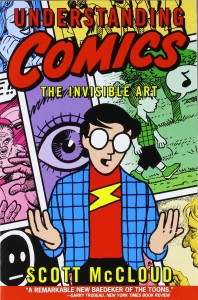 Invoking Scott McCloud’s Understanding Comics: The Invisible Art
Invoking Scott McCloud’s Understanding Comics: The Invisible Art, the stylized form encourages the player to project their own imagination into the less-detailed, less-realistic graphics and animations. This potentially gives it greater power to evoke emotional reactions than the most photorealistic graphics available today. The article makes several arguments and quotes people who know more about this than me, so I’ll let you read it.
But it’s kind of thought provoking.
Especially for people like me who grew up with the “low-res” 8-bit graphics, and dreamed of some day having graphics as detailed and realistic as we have today. I can’t deny that it’s cool, but graphical improvements haven’t taken gaming where I’d hoped it would go. Sorta like how live-action movies based on comics don’t always fulfill on their promises (although they are getting better!).
There’s something to be said for abstraction.
Filed Under: Art - Comments: 6 Comments to Read
Independence Day
Posted by Rampant Coyote on July 4, 2014
Here in the U.S., it’s the 4th of July – Independence Day. So to my friends in the U.S. or from the U.S., Happy Independence Day!
For everyone else out there, who didn’t have an Abraham Lincoln riding a bear into battle with an assault rifle, have an awesome Friday! Booyah!
(Okay, that may not be entirely historically correct, but that’s how it should have happened!)
Filed Under: General - Comments: Read the First Comment
